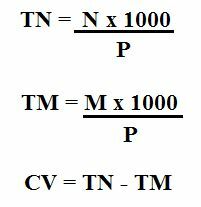THE birth rate and death rate they are statistical data according to the number of births and the number of deaths and, therefore, they determine the demographic growth of the population.
- Birth rate (TN): indicates the number of births per thousand inhabitants in a period of one year.
- Mortality rate (MT): corresponds to the number of annual deaths per thousand inhabitants.
The difference between birth and death rates is called vegetative growth (VC).
Birth and Mortality Rate in Brazil
During the last decades, Brazil has shown a great reduction in the birth and mortality rate.
This indicates that there was an improvement in the population's living conditions, from improved food, advances in medicine, access to education and health, among other factors.
According to IBGE surveys, the crude birth rate in Brazil per thousand inhabitants was 20.86 in 2000, and in 2015 it rose to 14.16. The mortality rate in 2000 was 6.67 and in 2015 it was 6.08.
Example:
In a city of 1000 inhabitants where the birth rate for one year was 30 children, this means that the birth rate for that year was 30%.
Likewise, if the number of deaths in the same city during a year was 10 people, the death rate will be 10%.

Where:
TN: birth rate
N: number of born
P: population
TM: mortality rate
CV: vegetative growth
Vegetative Growth
O vegetative growth it is a concept that is associated with population growth, being determined according to the socioeconomic and cultural conditions of a country.
In short, vegetative growth corresponds to the difference between the birth rate and the death rate.
These statistical values are classified in three ways:
- Vegetative growth is positive when the number of births exceeds the number of deaths.
- Vegetative growth is negative when the number of deaths exceeds the number of births.
- Vegetative growth can be null when the number of registered births is equivalent to the number of deaths in the same period of time.
Fertility Rate
Associated with the concept of birth, the fertility rate it is a statistic that indicates the average number of children that a woman has during her childbearing age (from 15 to 50 years approximately).
In recent decades, research on the fertility rate indicates a decrease in different parts of the world, especially in developed countries.
Therefore, this data is very relative, since it varies a lot from country to country, according to socioeconomic conditions.
According to IBGE data, in Brazil the fertility rate has been decreasing, so that in 2000 it was 2.4 and in 2015 it was 1.7.
Child mortality
THE child mortality corresponds to the death of children between zero and twelve months old.
Although infant mortality has decreased, it is still a reality in many parts of the world, especially in those places that have the worst living conditions, from lack of basic sanitation and access to education and health, proliferation of diseases, among others.
Life expectancy
THE Life expectancy, also called “life expectancy”, corresponds to the number of years reached by a population in a given period of time.
Over the years, this data has fortunately increased in different parts of the world. Currently, in Brazil, life expectancy is 75 years.
Know more about:
- Brazilian Age Pyramid
- Population growth


